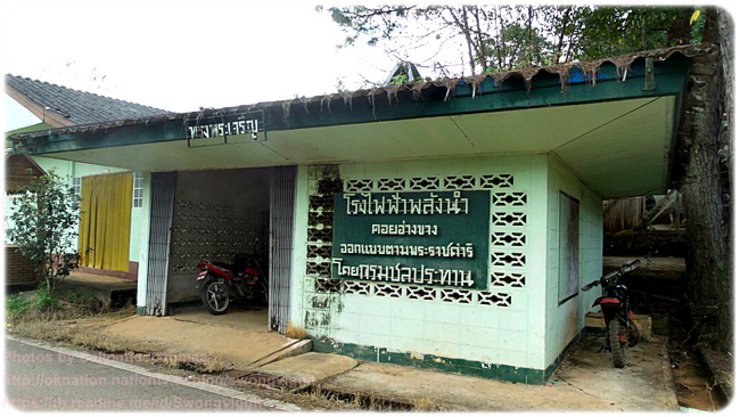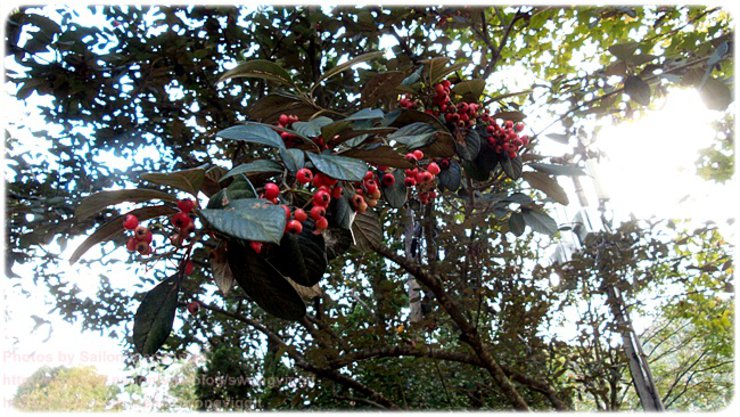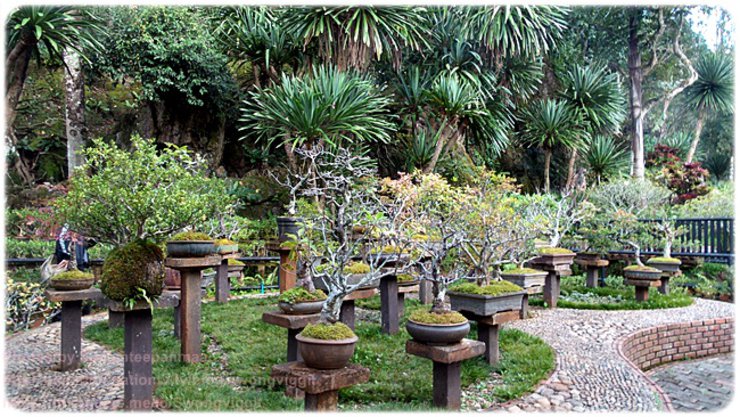
The First Hydroelectric Power Plant of Doi Ang Khang, built by the Royal Irrigation Department, is currently out of service.
The helicopter landed at the edge of the clearing, and as we discussed the challenges of farming on the mountain, the importance of water management for agriculture and daily life became clear. Our guide, Mr. Montri, spoke of the King's foresight in this regard, highlighting his vision in ordering the construction of small ponds, reservoirs, and water systems to collect water from mountain springs and assist local communities with water management.
Despite the availability of water, electricity from the city was still unavailable. Therefore, His Majesty the King had the idea to establish a hydroelectric power plant on Doi Ang Khang. Currently, Doi Ang Khang has electricity supplied from the city.

Beautiful flowering trees are planted all along the way.

We reached the bonsai garden, located near the end of the Doi Ang Khang tourist trail. This area is dedicated to the cultivation of bonsai trees and features a beautiful Japanese garden. Local hill tribe members serve as caretakers, promoting community employment.


Bonsai Garden on Doi Ang Khang
Note: This translation is concise and avoids personal pronouns and colloquialisms. It also maintains a formal tone and uses the active voice.



Minister Mantry further explained that in the past, most hill tribe people in the Doi Ang Khang area relied on the destruction of forest resources and headwaters, which are important sources for the ecosystem. This caused damage to other parts of the country. Therefore, His Majesty the King had the idea that this area has a cold climate, a lot of opium is grown, there are no forests at all, and the terrain is not very steep. Moreover, His Majesty knew that the hill tribe people earned as much money from growing opium as they did from growing local plums. He also knew that the Mountainous Fruit Experiment Station of Kasetsart University had experimented with grafting and budding with foreign plums. Therefore, he donated 1,500 baht of his own money to buy land and farms from the hill tribe people in part of Doi Ang Khang.


Note: The original text is empty, so the translation is also empty.
**The bonsai garden is beautifully maintained and decorated.**


The Royal Project at Ang Khang
In 1969, His Majesty King Bhumibol Adulyadej established the Royal Project as a personal initiative. He appointed Mom Rajawongse Bhisadej Rajani as the chairman of the Royal Project Foundation. The project aimed to serve as a research and experimental station for cultivating various temperate crops, including fruits, vegetables, and flowers. The goal was to provide a model for hill tribe farmers to adopt these crops as a source of income. Subsequently, the station was named "Ang Khang Royal Agricultural Station."


**Greenhouses for high-humidity crops, such as orchids**


Lady's slipper orchids and carnivorous plants such as pitcher plants and monkey cups.


Greenhouse for Drought-Tolerant Plant Varieties

Initially, promoting the cultivation of orchard and field crops instead of opium faced significant challenges. Villagers had been accustomed to opium cultivation throughout their lives, requiring agricultural extension officers to work diligently. They needed to assess villagers' preferences for alternative crops and provide support in planting and tending to them. His Majesty the King consistently monitored the progress of these efforts and offered guidance.




Subsequently, when villagers participate in deciding which crops to plant, they are more motivated and knowledgeable due to the project's support. As their agricultural plots yield results, their enthusiasm for farming grows. Seeing the success of those already involved, other villagers become more eager to join the project.


As we continued our walk, we engaged in conversation and gained insights into Mr. Montree's experiences serving His Majesty the King. While the journey was more comfortable than in the past due to improved roads, we couldn't help but wonder about the hardships faced by His Majesty during his royal visits. The distance was not insignificant, and even on this relatively comfortable path, we felt fatigue. Yet, His Majesty traversed routes filled with dirt, rocks, and dense forests. Despite the challenges, he persevered for the sake of his people.



Although the hill tribes have stopped cultivating opium and switched to growing temperate crops, the mission of the Angkhang Royal Agricultural Station is far from over. It continues to develop, experiment, and research to ensure that the people's agriculture is sustainable, resilient, and does not revert to opium cultivation.
Nestled in a region characterized by year-round cool temperatures, the Angkhang Royal Agricultural Station serves as the primary research hub for temperate fruit cultivation under the Royal Project. As the foremost research station for temperate fruits in Thailand, it has undertaken extensive research and propagation efforts for various plant species.









Following the successful production of various agricultural products, efforts were made to promote and develop the livelihoods of hill tribe farmers in the surrounding areas. These included various ethnic groups such as Palaung, Musoe, Tai Yai, and Chinese Haw. Various government agencies collaborated on this initiative through the Ang Khang Royal Development Project Center Working Group.






Kiwi fruit germplasm collection
The Angkhang Royal Agricultural Station also plays a vital role in collecting and studying various temperate fruit varieties, including peaches, pears, plums, apricots, kiwifruit, and strawberries, as we have witnessed throughout our journey.


Note: The original text is empty, so the translation is also empty.

The Angkhang Royal Agricultural Station also conducts research on various fast-growing tree species and bamboo varieties for reforestation purposes. These include fast-growing trees such as Erythrina subumbrans, fragrant maple, golden shower tree, Paulownia, jade bamboo, and Angkhang sweet bamboo.
Studies and trials have been conducted on various cut flower species, including roses, freesias, proteas, bulbs, and potted flowering plants. Additionally, research has been carried out on the collection of medicinal plants, various types of temperate vegetables, new vegetable varieties, and the study of specific plant species such as wheat and flax.



We walked along the path of the experimental vegetable plots, where there are many different kinds of vegetables that His Majesty has ordered to be tested and promoted for the hill tribe people to try planting. He has developed, reached out to, and understood the people for over 40 years of the Royal Angkhang Agricultural Project. Until this day, His Majesty has devoted his body and mind to achieving the sustainability we see today, all for the benefit of his people. There is no doubt that he is a true king of development.

สายลม ที่ผ่านมา
Friday, September 27, 2024 10:43 AM
















